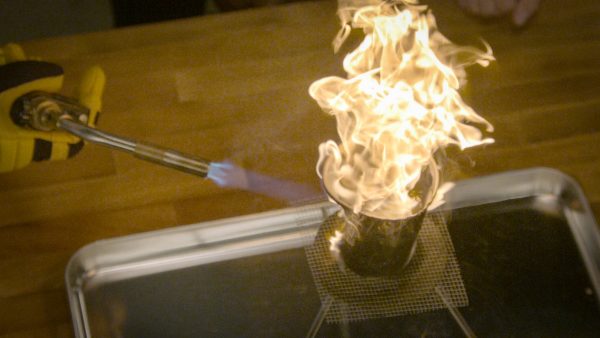Conduction Definition
Conduction transfers thermal energy through direct contact. For example, heating a copper bar melts chocolate bunnies on it.
View Lesson on Heat: Transfer of Thermal Energy
Become a member to get full access to our entire library of learning videos, reading material, quiz games, simple DIY activities & more.
Become a member to get full access to our entire library of learning videos, quiz games, & more.
Plans & Pricingto watch this full video.

Access All Videos
and Lessons, No Limits.
Access All Videos

No credit card required,
takes 7 sec to signup.
No card required

Ready-to-go lessons
that save you time.
Ready-to-go lessons
If you are on a school computer or network, ask your tech person to whitelist these URLs:
*.wistia.com, fast.wistia.com, fast.wistia.net, embedwistia-a.akamaihd.net
Sometimes a simple refresh solves this issue. If you need further help, contact us.
Heat: Transfer of Thermal Energy
Fun Facts
- A pot heats on a stove due to conduction.
- A thinner copper rod conducts thermal energy to melt chocolate faster due to fewer atoms.
- Thermal energy is transferred by conduction from the warmer object to the cooler object.
Why Do We Need To Know About Conduction
Learning about conduction helps us understand how energy moves through different materials. This is important for many reasons. For example, it helps us make clothes that keep us warm by stopping heat from escaping our bodies quickly, like what happens with thick jackets and special blankets.
This idea is also used to make better cooking tools like solar cookers, household items like irons, and to keep electronics from getting too hot. It’s even used in school experiments to explain hard ideas in an easier way. Knowing about conduction is useful in many areas of life.
Frequently Asked Questions
Check out the Full Lesson on Heat: Transfer of Thermal Energy
In this lesson, we learn that:
- Heat is the transfer of thermal energy from one object to another.
- Heating can occur by conduction, convection and radiation.
- Some materials can store more thermal energy than others.
Related Topics
- Algae Definition
- Analog Signal Definition
- Batteries Definition
- Biodiversity Definition
- Bioindicator Definition
- Body Fossils Definition
- Cast Fossils Definition
- Conduction Definition
- Convection Definition
- Definition Of Extreme Weather
- Ecosystem Definition
- Endoskeleton Definition
- Energy Conversion Definition
- Energy Transfer Definition
- Erosion Definition
- Extinct Definition
- Force Definition
- Hearing Definition
- Heat Definition
- Insulator Definition
- Life Cycle Definition
- Magma Definition
- Marsupial Definition
- Melting Definition
- Natural Resource Definition
- Newton’s 2nd Law Of Motion Definition
- Ocean Current Definition
- Organ Definition
- Organelle Definition
- Parasitism Definition
- Prey Definition
- Problem Definition
- Proton Definition
- Rain Definition
- Seed Definition
- Simple Machines Definition
- Solar System Definition
- Surface Runoff Definition
- Temperature Definition
- Trace Fossil Definition
- Transverse Wave Definition
- Unbalanced Force Definition
- Water Cycle Definition
- Water Definition
- Water Distribution Definition
- Wave Reflection Definition
- Weight Definition
- Wind Erosion Definition
Start a Free Trial Today. Get a $5 Amazon Gift Card!
Teachers! Start a free trial & we'll send your gift card within 1 day. Only cards left. Try it now.
Select Grade
Select Subject
This email is associated with a Science Kit subscription. Kit subscriptions are managed on this separate page: Manage Subscription

-
Download InvoiceScience & Math$/yr
-
Download InvoiceScience Only$/yr

access all lessons
• No credit card required •
"My students loved the videos. I started the video subscription in May and used them as a review before the state test, which I know contributed to 100% of my class passing the state test."
Rhonda Fox 4th Grade Teacher, Ocala, Florida
Use Generation Genius in Your School
Access all lessons free for 30 days.
"My students loved the videos. I started the video subscription in May and used them as a review before the state test, which I know contributed to 100% of my class passing the state test."
Rhonda Fox 4th Grade Teacher, Ocala, Florida
• No credit card required •
Already a member? Sign In
* no credit card required *

* no credit card required *
* no credit card required *


to Discover the Benefits of Generation Genius
Learn How to Save for Your School & District!

no credit card required
Skip, I will use a 3 day free trial
Enjoy your free 30 days trial
-
Unlimited access to our full library
of videos & lessons for grades K-5. -
You won’t be billed unless you keep your
account open past your 14-day free trial. -
You can cancel anytime in 1 click on the
manage account page or by emailing us.
-
Unlimited access to our full library of videos & lessons for grades K-5.
-
You won't be billed unless you keep your account open past 14 days.
-
You can cancel anytime in 1-click on the manage account page.
Cancel anytime in 1-click on the manage account page before the trial ends and you won't be charged.
Otherwise you will pay just $10 CAD/month for the service as long as your account is open.
Cancel anytime on the manage account page in 1-click and you won't be charged.
Otherwise you will pay $10 CAD/month for the service as long as your account is open.
We just sent you a confirmation email. Enjoy!
DoneWe use cookies to make your experience with this site better. By using this site you agree to our use of cookies. Click "Decline" to delete and block any non-essential cookies for this site on this specific property, device, and browser. Please read our privacy policy for more information on the cookies we use.Learn More
We use cookies to improve your experience. By using this site, you agree to our use of cookies. Click "Decline" to block non-essential cookies. See our privacy policy for details.Learn More




























































































































